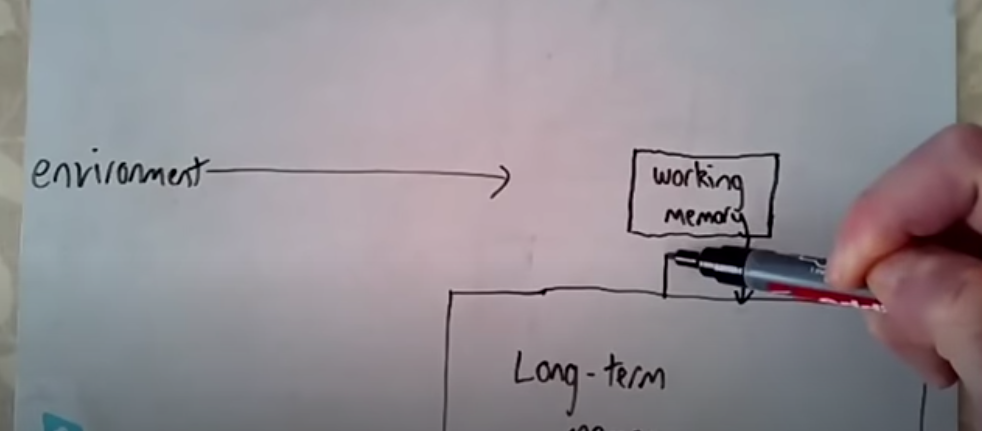
When my school district had to shut down suddenly last Spring because of the pandemic, I got to talk with several teachers about the sudden transition to online teaching. One of the most frequent comments I heard was “I miss my white board!”
I can relate to that feeling. I often use a white board when I teach, but I never thought deeply about the role of the white board in teaching before the pandemic. White boards are so ubiquitous, they are always just “there,” and I took them for granted. When we were suddenly restricted to just what we can share with our camera and screen sharing, I started to think about the teaching value of white boards.
As I thought and read a bit, I stumbled across the “Dynamic Drawing Principle.” The term refers to a teacher presentation choice: when a teacher draws or writes “live” in front of students (on a board, on paper via a document camera, etc.) rather than just showing something “finished” on a slide. This blog post about making effective instructional videos provides great advice overall, and mentions the dynamic drawing principle (good example of dynamic drawing at about 2:35 in the video embedded in the blog). If you’re looking for quick advice, Blake Harvard summarizes advice from that blog post effectively. This journal article found evidence supporting the idea that for some lessons, dynamic drawing helped students learn from a pre-recorded lecture about human biology. I think the best and most complete example comes from this fantastic ResearchEd video by Adam Boxer: the video starts rather abruptly with an extended example of dynamic drawing, and then transitions to a fabulous explanation of how dynamic drawing might help the learning process using current cognitive science principles (and he continues to use dynamic drawing throughout the video to help viewers understand the connections to memory theory, etc.)
Why might dynamic drawing be a big deal? If you are making videos to help people learn, you may want to look through the resources linked above to see when drawing and writing “live” in the video might help people learn. If you are able to teach students face to face in a classroom, thinking through the dynamic drawing principle can help make deliberate instructional choices: when do we want to use a static slide as we teach? When do we NOT want a slide because we instead want/need to draw and write on the board to demonstrate an idea?
I worry that the term Dynamic Drawing may cause some people to think that this idea is specific to “drawing.” Several of the examples above include writing words/numbers “live” for students while teaching. It’s not about drawing images, words, or numbers. I think the powerful learning element in dynamic drawing might be seeing a visual representation of an idea “appear” as a teacher writes it on a board, piece of paper, etc. instead of seeing a finished product. It’s possible that seeing an idea develop as a teacher draws/writes it helps our working memory focus on just the “right part” of the idea. Perhaps seeing the idea gradually unfold helps with selection attention and cognitive load? I’m excited to read more research and see teachers’ examples of the power of dynamic drawing.
I’m also trying to think about when I might use the dynamic drawing principle in the classroom. Three thoughts:
– Thought #1 – a Process: if I want to show a process, I think dynamic drawing might work better than a static slide. You can add animations to a slide, but I always end up pointing at the animation anyway, and often the animation plays faster or slower than I want it to. Drawing the process on the board or document camera would provide a lot more control. My textbook had professionally drawn images of the classical conditioning process, but I always chose to diagram examples of classical conditioning on the board instead. There was something about labelling each part of the diagram in front of students that helped us all think through the process together at a useful pace.
– Thought #2 – a Reveal: sometimes you want to emphasize a term or element of a problem/concept, and the dynamic drawing principle could help with a dramatic “reveal” that could emphasize importance, etc. to students. There’s no digital substitute for a dramatically drawn huge arrow or circle for the key part of the answer to a question, etc. When I taught the history of psychology, I loved the dramatic reveal that my alma mater, the University of Nebraska, was (for a time) one of the top three most important colleges for psychology research and majors.
– Thought #3 – using a Diagram: when I taught introductory psychology, there were several diagrams that helped students understand tough concepts, and I often wanted to make sure students could draw these diagrams themselves. Drawing these diagrams in front of students on the board was a good scaffold to help them draw their own diagram later. Teaching the differences between positive/negative reinforcement/punishment is tricky, but helping students learn to draw their own 2 by 2 grid helps a lot.
I would love to hear from some of you about what you think of the dynamic drawing principle and your examples from your classrooms. Draw on!